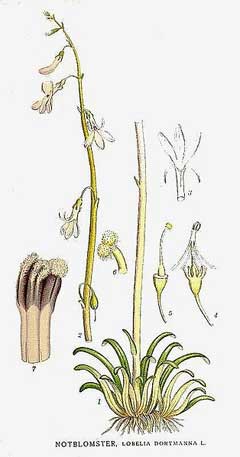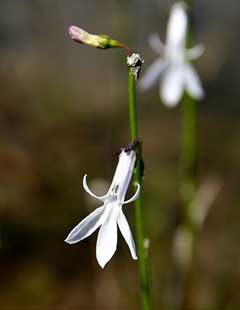 |
|
http://commons.wikimedia.org/wiki/File:58_Lobelia_dortmanna.jpg |
 |
| http://commons.wikimedia.org/wiki/User:Przykuta |
Translate this page:
Summary
Physical Characteristics

 Lobelia dortmanna is a PERENNIAL growing to 0.3 m (1ft). It is in flower from July to August. The species is hermaphrodite (has both male and female organs).
Lobelia dortmanna is a PERENNIAL growing to 0.3 m (1ft). It is in flower from July to August. The species is hermaphrodite (has both male and female organs).
Suitable for: light (sandy), medium (loamy) and heavy (clay) soils. Suitable pH: mildly acid, neutral and basic (mildly alkaline) soils. It can grow in semi-shade (light woodland) or no shade. It prefers moist or wet soil.
UK Hardiness Map
US Hardiness Map
Synonyms
Plant Habitats
Bog Garden;
Edible Uses
References More on Edible Uses
Medicinal Uses
Plants For A Future can not take any responsibility for any adverse effects from the use of plants. Always seek advice from a professional before using a plant medicinally.
Antiasthmatic Antispasmodic Diaphoretic Diuretic Emetic Expectorant Miscellany Nervine
A tincture of the fresh plant can cure headaches and noises in the ears[4]. The following notes are for L. inflata - this species is said to have similar actions[4]. Indian Tobacco was a traditional North American Indian remedy for a wide range of conditions[254]. Nowadays it is used mainly as a powerful antispasmodic herb in the treatment of respiratory and muscle disorders[254]. Acting also as a respiratory stimulant, Indian Tobacco is a valuable remedy for conditions such as bronchial asthma and chronic bronchitis[254]. The dried flowering herb and the seed are antiasthmatic, antispasmodic, diaphoretic, diuretic, emetic, expectorant and nervine[4, 7, 21, 46, 165, 171]. The plant is taken internally in the treatment of asthma, bronchitis, whooping cough and pleurisy[238]. This remedy should be used with great caution and only under the supervision of a qualified practitioner[7, 21, 165]. Excess doses cause nausea, vomiting, drowsiness and respiratory failure[238]. See also the notes above on toxicity. The plant contains the alkaline 'lobeline' which has proved to be of value in helping people to give up smoking tobacco[7, 200, 213]. It is contained in many proprietary anti-smoking mixtures where it mimics the effects of nicotine[238]. The alkaloids present in the leaves are used to stimulate the removal of phlegm from the respiratory tract[213]. When chewed, the leaves induce vomiting, headache and nausea - in larger doses it has caused death[213]. The alkaloids first act as a stimulant and then as a depressive to the autonomic nervous system and in high doses paralyses muscular action in the same way as curare[213]. Externally, the plant is used in treating pleurisy, rheumatism, tennis elbow, whiplash injuries, boils and ulcers[238]. The whole plant is harvested when the lower fruits are ripe and it is used fresh or dried[238].
References More on Medicinal Uses
The Bookshop: Edible Plant Books
Our Latest books on Perennial Plants For Food Forests and Permaculture Gardens in paperback or digital formats.

Edible Tropical Plants
Food Forest Plants for Hotter Conditions: 250+ Plants For Tropical Food Forests & Permaculture Gardens.
More

Edible Temperate Plants
Plants for Your Food Forest: 500 Plants for Temperate Food Forests & Permaculture Gardens.
More

More Books
PFAF have eight books available in paperback and digital formats. Browse the shop for more information.
Shop Now
Other Uses
References More on Other Uses
Cultivation details
Succeeds in full sun or light shade[200]. Grows well in heavy clay soils.
References Carbon Farming Information and Carbon Sequestration Information
Temperature Converter
Type a value in the Celsius field to convert the value to Fahrenheit:
Fahrenheit:
The PFAF Bookshop
Plants For A Future have a number of books available in paperback and digital form. Book titles include Edible Plants, Edible Perennials, Edible Trees,Edible Shrubs, Woodland Gardening, and Temperate Food Forest Plants. Our new book is Food Forest Plants For Hotter Conditions (Tropical and Sub-Tropical).
Shop Now
Plant Propagation
Seed - best sown as soon as it is ripe in a cold frame[200]. When they are large enough to handle, prick the seedlings out into individual pots and grow them on in the greenhouse for their first winter. Plant them out into their permanent positions in late spring or early summer, after the last expected frosts. Division in spring[200]. Basal cuttings in spring[1]. Harvest the shoots when they are about 10cm long with plenty of underground stem. Pot them up into individual pots and keep them in light shade in a cold frame or greenhouse until they are rooting well. Plant them out in the summer. Layering in moist sand, it forms roots at the nodes[200].
Other Names
If available other names are mentioned here
Native Plant Search
Search over 900 plants ideal for food forests and permaculture gardens. Filter to search native plants to your area. The plants selected are the plants in our book 'Plants For Your Food Forest: 500 Plants for Temperate Food Forests and Permaculture Gardens, as well as plants chosen for our forthcoming related books for Tropical/Hot Wet Climates and Mediterranean/Hot Dry Climates. Native Plant Search
Found In
Countries where the plant has been found are listed here if the information is available
Weed Potential
Right plant wrong place. We are currently updating this section.
Please note that a plant may be invasive in one area but may not in your area so it’s worth checking.
Conservation Status
IUCN Red List of Threatened Plants Status :

Growth: S = slow M = medium F = fast. Soil: L = light (sandy) M = medium H = heavy (clay). pH: A = acid N = neutral B = basic (alkaline). Shade: F = full shade S = semi-shade N = no shade. Moisture: D = dry M = Moist We = wet Wa = water.

Expert comment
Author
L.
Botanical References
17
Links / References
For a list of references used on this page please go here
Readers comment
| Add a comment |
|
If you have important information about this plant that may help other users please add a comment or link below. Only comments or links that are felt to be directly relevant to a plant will be included. If you think a comment/link or information contained on this page is inaccurate or misleading we would welcome your feedback at [email protected]. If you have questions about a plant please use the Forum on this website as we do not have the resources to answer questions ourselves.
* Please note: the comments by website users are not necessarily those held by PFAF and may give misleading or inaccurate information.
To leave a comment please Register or login here All comments need to be approved so will not appear immediately.
|
Subject : Lobelia dortmanna
|
|
|
|